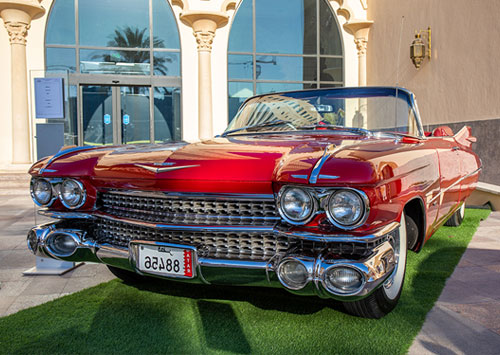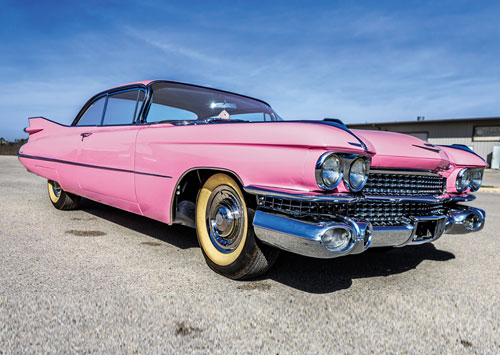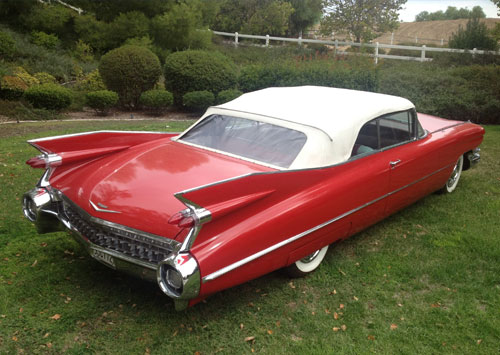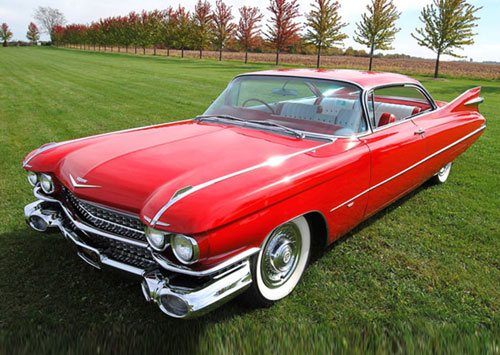
Join us and be an active member and benefit from our services
Cadillac De Ville 1959
The Cadillac DeVille was originally a trim level and later a separate model produced by Cadillac. The first car to bear the name was the 1949 Coupe de Ville, a pillarless two-door hardtop body style with a prestige trim level above that of the Series 62 luxury coupe. The last model to be formally known as a DeVille was the 2005 Cadillac DeVille, a full-size sedan, the largest car in the Cadillac model range at the time. The next year, the DeVille was officially renamed the Cadillac DTS.
The name "DeVille" is derived from the French de la ville or de ville meaning "of the town".[1] In French coach building parlance, a coupé de ville, from the French couper (to cut) i.e. shorten or reduce, was a short four-wheeled closed carriage with an inside seat for two and an outside seat for the driver and this smaller vehicle was intended for use in the town or city (de ville). An (unshortened) limousine or (in the United States) town car has a division between the passenger and driver compartments and if the driver's seat is outside it may be called a sedanca de ville or town car.
he first Cadillac "Coupe de Ville" was shown during the 1949 Motorama. It was built on a Cadillac Sixty Special chassis and featured a dummy air-scoop, chrome trim around front wheel openings, and a one-piece windshield and rear glass. The interior was black and trimmed in gray leather, including the headliner, to match the roof color. It was equipped with a telephone in the glove compartment, a vanity case and a secretarial pad in the rear armrest, power windows and highly decorative chrome interior trim. The prototype "Coupe de Ville" was used by GM President Charles E. Wilson until 1957 when he presented it to his secretary. At some time during this period it acquired a dark Vicodec roof. The prototype "Coupe de Ville" was found and restored in the 2nd decade of the New Millennium; it is currently (2016–17) in a private collection in London, Ontario, Canada.
The Cadillac Series 62 Coupe de Ville was introduced late in the 1949 model year. Along with the Buick Roadmaster Riviera, and the Oldsmobile 98 Holiday, it was among the first pillarless hardtop coupes ever produced. At $3,496 it was only a dollar less than the Series 62 convertible, and like the convertible, it came with power windows standard. It was luxuriously trimmed, with leather upholstery and chrome 'bows' in the headliner to simulate the ribs of a convertible top. In its first year the Series 62 Coupe de Ville only sold 2,150 units. But 1950 sales more than doubled to 4507, and in 1951 sales more than doubled again to 10,241 exceeding the sales for the Series 62 Club Coupe that year. Also, in 1951, Coupe de Ville chrome script appeared on the rear roof pillar for the first time, to further distinguish it from the Series 62 Club Coupe.
In 1956 the Series 62 Coupe de Ville was joined by the Series 62 Sedan de Ville, Cadillac's first standard production 4-door hardtop. Similarly to the Coupe de Ville, it was also more expensive and more luxuriously trimmed that the standard 4-door Series 62. With 41,732 sold, it also easily outsold the Series 62 sedan in its very first year. Given their sales success, it was only natural that the Coupe de Ville and Sedan de Ville were moved to their own separate series in 1959, the Series 6300, being joined by a DeVille convertible in 1964.
The 1959 Cadillac is remembered for its huge sharp tailfins with dual bullet tail lights, two distinctive rooflines and roof pillar configurations, new jewel-like grille patterns and matching deck lid beauty panels.[5] In 1959 the Series 62 were moved from the Series 62 to their own series, the Series 6200. DeVilles and 2-door Eldorados became the Series 6300 and Series 6400 respectively, though they all, including the 4-door Eldorado Brougham (which was moved from the Series 70 to Series 6900), shared the same 130 in (3,302 mm) wheelbase. Engine output was an even 325 hp (242 kW) from the 390 cu in (6.4 L) engine. The DeVille Series had script nameplates on the rear fenders. Standard equipment included power brakes with 15-inch wheels,[6] power steering, automatic transmission, back-up lamps, windshield wipers, two-speed wipers, wheel discs, outside rearview mirror, vanity mirror, oil filter, power windows and two-way power seats. Plain fender skirts covered the rear wheels and 4-doors were available in either four-window or six-window hardtop configurations. Over 53,000 DeVilles were sold in their first year as a separate series, accounting for roughly 37% of all Cadillacs sold.
| # | Cadillac DeVille | 1959-1960 |
|---|---|---|
| § | Assembly | Detroit Assembly, Detroit, Michigan, U.S. |
| 2 | Designer | Bill Mitchell |
| 3 | Body style | 2-door hardtop |
| 4 | Layout | FR layout |
| 5 | Engine | 390 cu in (6.4 L) OHV V8 |
| 6 | Transmission | 4-speed Hydra-Matic |
| 7 | Wheelbase | 130.0 in (3,302 mm) |
| 8 | Length | 225.0 in (5,715 mm) |
| 9 | Width | 80.2 in (2,037 mm) |
| 10 | Height | 56.2 in (1,427 mm) |





